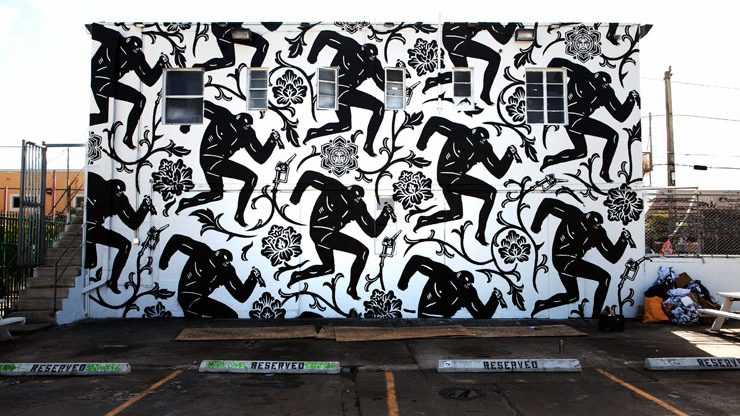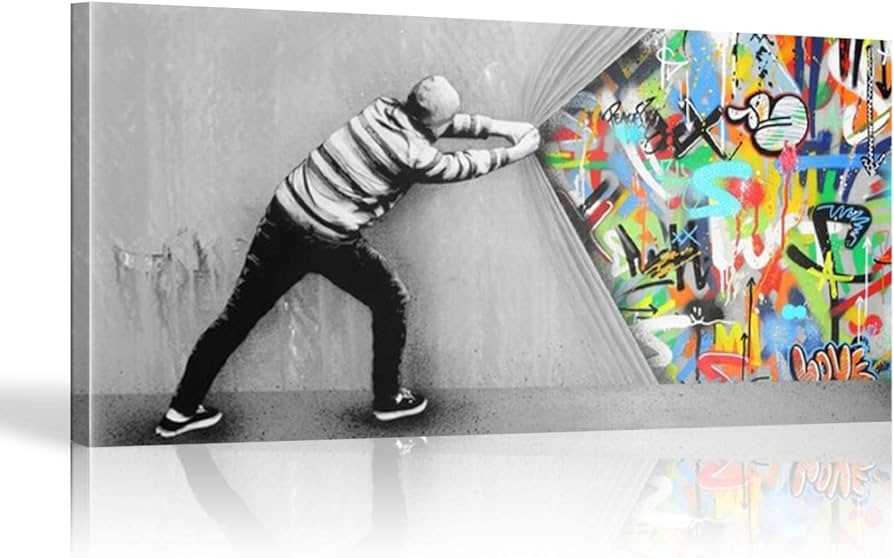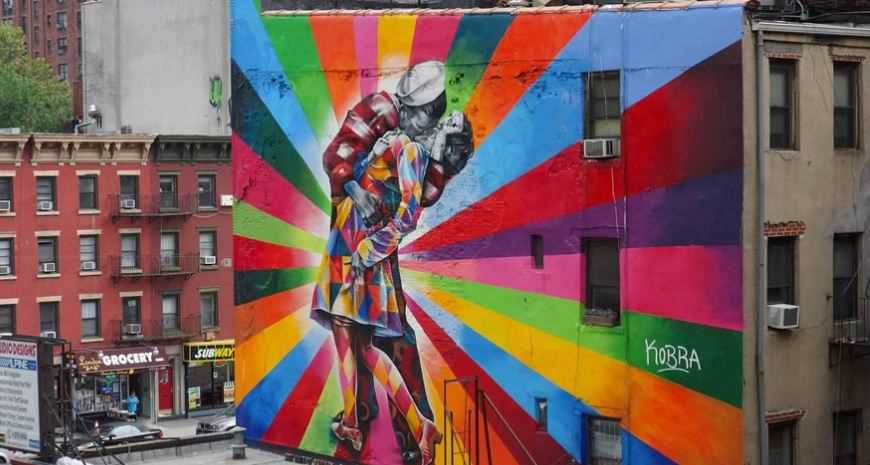
Contemporary street art is a vibrant and dynamic form of artistic expression that has emerged in cities around the world. It has transformed urban landscapes, adding color and creativity to once blank and uninspiring walls. Street art has evolved from its humble beginnings as graffiti to become a respected and celebrated art form.
What sets contemporary street art apart is its ability to capture the current cultural and social climate. Street artists use their work to comment on pressing issues such as politics, inequality, and environmental concerns. They employ various mediums, including spray paint, stencils, stickers, and installations, to create powerful and thought-provoking pieces.
With its roots in underground counter-culture movements, contemporary street art challenges traditional notions of art by embracing the streets as its gallery. It is accessible to everyone, regardless of their background or art knowledge, as it is freely available in public spaces. This democratization of art allows viewers to engage with and interpret the messages conveyed by street artists.

Graffiti is an ancient art form that has been used through the ages to express political views, make social commentary, and beautify public spaces. The history of graffiti can be traced back to the ancient civilizations of Egypt, Greece, and Rome, where citizens would paint messages, symbols, and images on walls to communicate with one another.
In the 20th century, graffiti began to take on a new form and gained recognition as a true art form. It emerged as a form of rebellion and self-expression in urban communities, with artists using spray paint, stencils, and markers to create intricate and colorful designs. Graffiti became a way for marginalized groups to reclaim public spaces and express their frustrations and aspirations.
Birth of the Street Art Movement

In the 1970s, graffiti became a prominent feature of the hip-hop culture in New York City. The streets of the city became a canvas for artists like Keith Haring and Jean-Michel Basquiat, who used graffiti to make bold political statements and challenge the status quo. This marked the birth of the street art movement, which continues to thrive to this day.
Contemporary Graffiti

Contemporary graffiti has evolved from its humble beginnings, with artists using a variety of techniques and materials to create their work. From large-scale murals to smaller, intricate designs, contemporary graffiti can be found in cities all over the world. Street artists often address social and political issues, creating powerful and thought-provoking pieces that resonate with viewers.
| Tools | Materials |
|---|---|
| Spray paint | Brick walls |
| Stencils | Wooden boards |
| Markers | Metal surfaces |
| Paintbrushes | Canvas |
Graffiti has come a long way from its controversial beginnings. It has gained recognition as a legitimate art form, with museums and galleries showcasing the works of street artists. Graffiti continues to push boundaries and challenge societal norms, making it an integral part of contemporary street art.
Stencil Art: Technique and Style

Stencil art is a popular form of street art that involves creating images and designs using stencils. This technique has its roots in graffiti and has evolved into a recognized art form with its own unique style.
The process of creating stencil art involves cutting out designs or images from a material such as paper, cardboard, or metal. The cut-out sections are then used as a template for spraying or painting the desired image onto a surface, such as a wall or canvas.
One of the main advantages of using stencils is the ability to quickly reproduce the same image multiple times. Artists can create intricate designs with precise details by carefully cutting out the stencil shapes. This allows for consistent and uniform images, making stencil art a highly recognizable and impactful style.
Stencil art can be used to create a wide range of images, from simple symbols and patterns to complex portraits and landscapes. Artists often use bold, contrasting colors to make their stenciled images stand out and grab attention.
This art form has gained popularity in recent years and has become a powerful medium for social and political commentary. Many artists use stencils to convey powerful messages about society, culture, and the human condition.
Stencil art can be found in various urban environments, such as alleys, abandoned buildings, and street art festivals. It has become a part of the contemporary art scene, attracting both locals and tourists who appreciate its unique blend of creativity and social commentary.
Overall, stencil art is a versatile and impactful form of street art that continues to evolve and inspire. Its technique of using stencils allows artists to create consistent and bold images, while its style offers a platform for expressing powerful messages. Whether it’s a simple symbol or a complex portrait, stencil art has become an integral part of contemporary street art culture.
Spray Painting: Exploring Colors and Textures

Spray painting is a popular technique in contemporary street art, allowing artists to create vibrant and dynamic pieces with a wide range of colors and textures. With a spray can in hand, artists can quickly cover large surfaces and layer different colors to achieve unique effects.
One of the main advantages of spray painting is the ability to easily blend colors. Artists can create smooth transitions between hues, giving their artwork a sense of depth and dimension. This technique allows for endless possibilities in terms of color combinations, enabling artists to create bold and eye-catching compositions.
Textures also play a crucial role in spray painting. Artists can experiment with different nozzles and techniques to achieve various textures, from smooth and glossy finishes to rough and gritty surfaces. By varying the pressure and distance from the surface, artists can create different effects, adding depth and interest to their artwork.
Another interesting aspect of spray painting is the interaction between the paint and the surface. Different surfaces can affect the final result, with some absorbing the paint, while others repel it. This interaction can add unexpected and unique elements to the artwork, making each piece truly one-of-a-kind.
Furthermore, spray painting allows for quick and spontaneous creation. The fast-drying nature of spray paint allows artists to work rapidly, capturing their ideas and emotions in the moment. This immediacy adds a sense of energy and excitement to the artwork, reflecting the vibrant and dynamic nature of contemporary street art.
| Benefits of Spray Painting in Street Art: |
|---|
| Ability to blend colors for smooth transitions |
| Exploration of different textures using various techniques |
| Interaction between the paint and the surface for unique results |
| Quick and spontaneous creation process |
Walls as a Canvas: Transforming Urban Spaces

The art of street painting has evolved significantly over the years, with walls serving as a blank canvas for creative expression. What was once seen as vandalism is now celebrated as a vibrant form of art that brings life to urban spaces.
Contemporary street art goes beyond mere graffiti by incorporating various elements, such as stencils, murals, and installations. Artists use walls as their medium to make powerful statements about social issues, politics, and culture.
One of the main attractions of street art is its accessibility. Unlike traditional art, which is often displayed in museums and galleries, street art can be found in unexpected places. It engages with a wider audience, transcending the boundaries of age, race, and socioeconomic status.
What makes street art truly unique is its ephemeral nature. Unlike traditional art forms that are meant to last for centuries, street art may fade or be painted over. This impermanence adds an element of excitement and urgency to the creation and appreciation of street art.
Furthermore, street art has the ability to transform neglected and abandoned areas into vibrant cultural hubs. By breathing new life into otherwise mundane spaces, it fosters a sense of community and pride. Street art can revitalize neighborhoods, making them more attractive to residents and visitors alike.
As street art continues to gain recognition and appreciation, cities around the world are embracing it as a legitimate form of art. In some cases, street art is even commissioned by local governments to beautify urban landscapes and deter vandalism.
Street Art Murals: Captivating Stories and Themes

The Power of Visual Storytelling

Street art murals have the ability to captivate viewers and transport them into different worlds. They often depict scenes and narratives that evoke strong emotions and provoke thought. From social and political commentary to personal experiences and cultural heritage, each mural tells a story in its own way.
Themes and Motifs

Street artists explore a wide range of themes and motifs in their murals. Some focus on social issues such as inequality, racism, environmental conservation, and human rights. These murals serve as a powerful medium to raise awareness and encourage dialogue about important issues.
Other artists draw inspiration from nature, history, and mythology, creating murals that are not only visually appealing but also educational. These themes can take viewers on a journey through time and space, connecting them to the past and the natural world.
Many street art murals also celebrate cultural diversity and heritage. Artists use their work to pay homage to the local community, its history, traditions, and cultural icons. These murals contribute to a sense of pride and belonging, bringing communities together.
Overall, street art murals serve as a powerful form of storytelling and expression. They have the ability to inspire, educate, and provoke thought, making them an integral part of the urban landscape.
Next time you encounter a street art mural, take a moment to appreciate the story it tells and the message it conveys.
Graffito and Tagging Culture: Rebel or Art?

Traditional graffiti, often characterized by painted words, images, or symbols, can be seen as a way for individuals to communicate their message to the public. It can provide a voice to those who feel marginalized or unheard, acting as a visual representation of their beliefs, ideas, or criticisms. It has the power to challenge societal norms and provoke thought, forcing viewers to confront their own assumptions and biases.
Tagging, on the other hand, is often dismissed as mere vandalism or an act of territorial marking. However, it can also be seen as a unique art form, with its own set of aesthetic qualities. The intricate lettering and elaborate designs often seen in tagging can showcase the artist’s skill and creativity. Taggers often develop their own unique style, incorporating elements of calligraphy, typography, and graphic design. These forms of art can be seen as a part of the larger urban landscape, adding vibrancy and visual interest to otherwise mundane surroundings.
Despite the controversy surrounding graffiti and tagging, many cities and communities are beginning to recognize their cultural and artistic value. Street art festivals and open-air galleries are emerging, providing a space for artists to showcase their talent legally and gain recognition for their work. With the rise of social media, these forms of expression can now reach a global audience, allowing artists to share their message and gain followers from around the world.
| Pros | Cons |
|---|---|
| Acts as a powerful method of self-expression | Often seen as vandalism or a violation of property |
| Challenges societal norms and provokes thought | Can lead to visual clutter and a perception of an unsafe environment |
| Highlights marginalized voices and provides a platform for the unheard | May encourage illegal and unsanctioned activities |
| Contributes to urban vibrancy and visual interest | Can be costly to remove or restore |
Influence of Street Art on Modern Culture

Street art has become an influential part of modern culture, transforming the way people perceive and interact with art. Its impact is evident in various aspects of society, ranging from urban landscapes to popular culture. Here are some ways in which street art has influenced modern culture:
1. Shaping Urban Aesthetics

Street art has the power to completely transform the look and feel of a city. Previously dull and lifeless walls are turned into vibrant canvases, adding color and creativity to urban environments. This infusion of art into public spaces not only beautifies the surroundings but also creates a sense of identity and pride within communities.
2. Challenging Traditional Art Boundaries

Street art pushes the boundaries of traditional art by breaking free from the confines of galleries and museums. It allows artists to reach a wider audience and make their art accessible to everyone. This democratic approach to art challenges the elitism often associated with traditional art, making it more inclusive and relatable.
3. Promoting Social and Political Messages

Street art has often served as a platform for expressing social and political messages. Artists use their work to raise awareness about important issues, such as inequality, racism, and environmental concerns. By utilizing public spaces, street art becomes a powerful medium for initiating conversations and sparking change.
Furthermore, street art encourages viewers to question societal norms and engage with their surroundings critically. It provokes thought, encourages dialogue, and challenges the status quo.
4. Inspiring other Art Forms

Street art has greatly influenced other forms of art, such as graffiti, illustration, and graphic design. Its bold and unconventional style has served as inspiration for artists in various disciplines. The fusion of street art with traditional art forms has resulted in the emergence of unique and innovative artistic expressions.
5. Establishing Street Artists as Recognized Artists

Street art has played a significant role in legitimizing street artists as recognized artists within the art world. Many street artists have successfully transitioned from creating illegal graffiti to exhibiting their work in galleries and museums. This shift in perception has resulted in street art being recognized as a legitimate and valuable art form.
The Future of Contemporary Street Art
Contemporary street art has evolved from being viewed as vandalism to being recognized as a legitimate form of artistic expression. As we look to the future, the impact of street art is only expected to grow.
One possible future for contemporary street art is its integration into mainstream art institutions. Museums and galleries are increasingly recognizing the value and significance of street art, and are curating exhibitions and installations that showcase the best of this genre. This acceptance and inclusion of street art in traditional art spaces will not only provide greater exposure for the artists, but it will also elevate the status of street art as a respected art form.
Technology is also likely to play a significant role in the future of street art. Artists are already experimenting with new mediums and techniques, such as augmented reality and interactive installations. These advancements allow for a more immersive and dynamic experience for both the artist and the viewer. With the rapid pace of technological advancements, we can expect to see even more innovative approaches to street art in the coming years.
The future of street art is also tied closely to social and political movements. Murals and graffiti have long been used as a means of expression and protest, and this is unlikely to change. Street artists will continue to use their work to raise awareness about important social issues, provoke thought, and challenge the status quo. The power of street art to inspire change and spark conversations is a force that will endure.

I am a mural enthusiast and a fervent admirer of street art. Rather than creating murals myself, I am passionate about collecting them. My love for street art knows no bounds. I am dedicated to curating and cherishing these artworks that grace the streets. My collection stands as a testament to my profound appreciation for this form of artistic expression.
read about me



